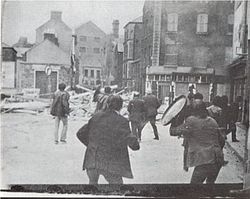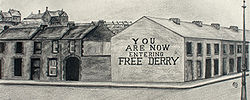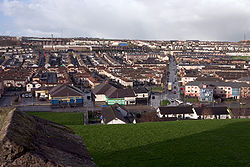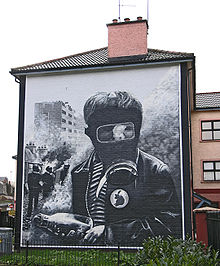- Battle of the Bogside
-
Battle of the Bogside Part of The Troubles and the
1969 Northern Ireland riots
Bogsiders defending their barricades Date 12–14 August 1969 Location Derry, Northern Ireland Result British Army deployed to restore order in Northern Ireland,
Free Derry becomes a no-go areaCauses (see background) Characteristics large-scale rioting Parties to the civil conflict Derry Citizens' Defence Association and residents of the Bogside Royal Ulster Constabulary Lead figures Paddy Doherty
Bernadette Devlin
Eamonn McCannNumber uncertain 691 Casualties at least 1,000 injured[citation needed] at least 350 injured The Battle of the Bogside was a very large communal riot that took place during 12–14 August 1969 in Derry, Northern Ireland. The fighting was between residents of the Bogside area (allied under the Derry Citizens' Defence Association) and the Royal Ulster Constabulary (RUC).
The rioting erupted after the RUC attempted to disperse Irish nationalists who were protesting against a loyalist Apprentice Boys parade along the city walls, past the nationalist Bogside. Rioting continued for three days in the Bogside. The RUC was unable to enter the area and the British Army was deployed to restore control. The riot, which sparked widespread violence elsewhere in Northern Ireland, is commonly seen as one of the first major confrontations in the conflict known as the Troubles.
Contents
Background
Tensions had been building in Derry for over a year before the Battle of the Bogside. In part, this was due to long-standing grievances held by much of the city's population. The city had a majority Catholic and nationalist population. In 1961, for example, the population was 53,744, of which 36,049 was Catholic and 17,695 Protestant.[1] However after the partition of Ireland in 1921, it had been ruled by the Unionist-dominated government of Northern Ireland.
Nationalist grievances
Unionists maintained political control of Derry by two means. Firstly, electoral wards were designed so as to give unionists a majority in the city. The "Londonderry County Borough", which covered the city, had been won by nationalists in 1921. It was recovered by unionists, however, following re-drawing of electoral boundaries by the unionist government in the Northern Ireland parliament.[2]
As a result, although Catholics made up 60% of Derry's population in 1961,[3] due to the division of electoral wards, unionists had a majority of 12 seats to 8 on the city council. When there arose the possibility of Nationalists gaining one of the Unionist wards, the boundaries were redrawn to maintain Unionist control.[4] Control of the city council gave Unionists control over the allocation of public housing, which they allocated in such a way as to keep the Catholic population in a limited number of wards.[1] This policy had the additional effect of creating a housing shortage for Catholics.
Secondly, only owners or tenants of a dwelling and their spouses were allowed to vote in local elections.[2] Nationalists argued that these practices were retained by Unionists after their abolition in Great Britain in 1945 in order to reduce the anti-Unionist vote.[2][5] Figures show that, in Derry city, Nationalists comprised 61.6% of parliamentary electors, but only 54.7% of local government electors.[6] Catholics also alleged discrimination in employment.[2]
Another grievance, highlighted by the Cameron Commission into the riots of 1969, was the issue of perceived regional bias; where Northern Ireland government decisions alleged to favour the mainly Protestant east of Northern Ireland rather than the mainly Catholic west.[7] Examples of such controversial[2] decisions affecting Derry were the decision to close the anti-submarine training school in 1965, adding 600 to an unemployment figure already approaching 20%; the decision to site Northern Ireland's new town at Craigavon and the siting of Northern Ireland's second University in the mainly unionist town of Coleraine rather than Derry, which was four times larger.[8]
Activism
In March 1968, a small number of activists in the city founded the Derry Housing Action Committee, with the intention of forcing the government of Northern Ireland to change their housing policies. This groups founders were mostly local members of the Northern Ireland Labour Party, such as Eamonn McCann and members of the James Connolly Republican Club (the Northern manifestation of Sinn Féin, which was banned in Northern Ireland). The Housing Action Committee took direct action such as blocking roads and attending local council meetings uninvited in order to force them to house Catholic families who had been on council's housing waiting list for a long time. By the summer of 1968, this group had linked up with the Northern Ireland Civil Rights Association and were agitating for a broader program of reform within Northern Ireland.[9]
On 5 October 1968, these activists organised a march through the centre of Derry. However, the demonstration was banned. When the marchers, including Members of Parliament Eddie McAteer and Ivan Cooper, defied this ban they were batoned by the RUC. The RUC's actions were televised and caused widespread anger in nationalist circles. The following day, 4000 people demonstrated in solidarity with the marchers in Guildhall Square in the centre of Derry. This march passed off peacefully, as did another demonstration attended by up to 15,000 people on 16 November. However, these incidents proved to be the start of an escalating pattern of civil unrest, that culminated in the events of August 1969.[10]
 Free Derry Corner in the Bogside; the slogan "You are now entering Free Derry" was first painted in January 1969 by John Casey
Free Derry Corner in the Bogside; the slogan "You are now entering Free Derry" was first painted in January 1969 by John Casey
January to July, 1969
In January 1969, a march by the radical nationalist group People's Democracy from Belfast to Derry was attacked by loyalists at Burntollet, five miles outside Derry. It is alleged that the RUC failed to protect the march. When the marchers (many of whom were injured) arrived in Derry on 5 January, rioting broke out between their supporters and the RUC. That night, RUC officers broke into homes in the Catholic Bogside area and assaulted several residents. An inquiry led by Lord Cameron concluded that, "a number of policemen were guilty of misconduct, which involved assault and battery, malicious damage to property...and the use of provocative sectarian and political slogans".[11] After this point, barricades were set up in the Bogside and vigilante patrols organised to keep the RUC out. It was at this point that the famous mural with the slogan "You are now entering Free Derry" was painted on the corner of Columbs Street by a local activist named John Casey.
On 19 April there were clashes between NICRA marchers, loyalists and the RUC in the Bogside area. RUC officers entered the house of Samuel Devenny (42), a local Catholic who was not involved in the riot, and severely beat him with batons. His teenage daughters were also beaten in the attack. Devenny died of his injuries on 17 July[12] and he is sometimes referred to as the first victim of The Troubles.[12] Others consider John Patrick Scullion, who was killed 11 June 1966 by the UVF, to have been the first victim of the conflict.[13]
On 12 July ("The Twelfth") there was further rioting in Derry, nearby Dungiven, and Belfast. The violence arose out of the yearly Orange Order marches. During the clashes in Dungiven, Catholic civilian Francis McCloskey (67) was beaten with batons by RUC officers and died of his injuries the following day.[12] Following these riots, Irish republicans in Derry set up the Derry Citizens Defence Association, with the intention of preparing for future disturbances. The members of the DCDA were initially Republican Club (and possibly IRA) activists, but they were joined by many other left-wing activists and local people. This group stated their aim as firstly to keep the peace, but if this failed, to organise the defence of the Bogside. To this end, they stockpiled materials for barricades and missiles, ahead of the Apprentice Boys of Derry march on 12 August.
The Apprentice Boys march
The annual Apprentice Boys parade on 12 August commemorated the Protestant victory in the Siege of Derry in 1689 and was considered highly provocative by many Catholics. Derry activist Eamonn McCann wrote that the march, "was regarded as a calculated insult to the Derry Catholics".[14]
Although the march did not pass through the Bogside, it passed close to it at the junction of Waterloo Place and William Street. It was here that trouble broke out. Initially, taunts were exchanged between the loyalists and Bogsiders. Stones were then thrown from both sides for a period, before the police forced the nationalists into Rossville Street and the Bogside itself.[15] They were followed by local supporters of the Apprentice Boys, and the confrontation escalated.[16]
Large crowds turned out in the Bogside, pelted the police with stones and Molotov cocktails, and manned pre-prepared barricades to block their progress - which the RUC tried to clear with armoured cars. Out of 59 officers who made the initial incursion, 43 were treated for injuries.[17]
The Battle
 A mural by the Bogside Artists at Free Derry Corner, depicting Bernadette Devlin during the riot
A mural by the Bogside Artists at Free Derry Corner, depicting Bernadette Devlin during the riot
The actions of the Bogside residents were co-ordinated to some extent. The Derry Citizens Defence Association set up a headquarters in the house of Paddy Doherty in Westland Street and tried to supervise the making of petrol bombs and the positioning of barricades. They also set up "Radio Free Derry." Many local people, however, joined in the rioting on their own initiative and impromptu leaders also emerged, such as Bernadette Devlin, Eamonn McCann and others.
Locals youths climbed onto the roof of the High Flats on Rossville Street, from where they bombarded the RUC below with missiles. When the advantage that this position possessed was realised, the youths were kept supplied with stones and petrol bombs.
The RUC were in many respects badly prepared for the "battle". Their riot shields were too small and did not protect their whole bodies. In addition, their uniforms were not flame resistant and a number were badly burned by petrol bombs. They possessed armoured cars and guns, but were not permitted to use them. Moreover, there was no system in place to relieve officers, with the result that the same policemen had to serve in the rioting for three days without rest.
The police responded to this situation by flooding the area with CS gas, which caused a range of respiratory injuries among the local people. A total of 1,091 canisters containing 12.5g of CS; and 14 canisters containing 50g of CS, were released in the densely populated residential area.[18] After two days of almost continuous rioting, during which police were drafted in from all over Northern Ireland, the RUC were exhausted, and were snatching sleep in doorways whenever the opportunity allowed.
On 13 August, Jack Lynch, Taoiseach of the Republic of Ireland made a televised speech about the events in Derry, in which he said that he "could not stand by and watch innocent people injured and perhaps worse." He promised to send the Irish Army to the border and to set up field hospitals for those injured in the fighting. Lynch's words were widely interpreted in the Bogside as promising that Irish troops were about to be sent to their aid. Unionists were appalled at this prospect, which they saw as a threatened invasion of Northern Ireland. In fact, although the Irish Army was indeed sent to the border, they restricted their activities to providing medical care for the injured.
By 14 August, the rioting in the Bogside had reached a critical point. Almost the entire community there had been mobilised by this point, many galvanised by false rumours that St Eugene's Cathedral had been attacked by the police. The RUC were also beginning to use firearms. Two rioters were shot and injured in Great James' Street. The B-Specials, an auxiliary, mostly Protestant police force, much feared by Catholics for their role in killings in the 1920s, were called up and sent to Derry, provoking fears of a massacre on the part of the Bogsiders.[19]
On the afternoon of the 14th, the Prime Minister of Northern Ireland, James Chichester-Clark, took the unprecedented step of requesting the British Prime Minister Harold Wilson for troops to be sent to Derry. Soon afterwards a company of the Prince of Wales Own Regiment relieved the police, with orders to separate the RUC and the Bogsiders, but not to attempt to breach the barricades and enter the Bogside itself. This marked the first direct intervention of the London government in Ireland since partition. The British troops were at first welcomed by the Bogside residents as a neutral force compared to the RUC and especially the B-Specials.
Only a handful of radicals in Bogside, notably Bernadette Devlin, opposed the deployment of British troops. This good relationship did not last long however, as the Troubles escalated.
Over 1000 people had been injured in the rioting in Derry, but no one was killed. A total of 691 RUC men were deployed in Derry during the riot, of whom only 255 were still in action at 12.30 on the 15th. Manpower then fluctuated for the rest of the afternoon: the numbers recorded are 318, 304, 374, 333, 285 and finally 327 at 5.30 pm While some of the fluctuation in numbers can be put down to exhaustion rather than injury, these figures indicate that the RUC suffered at least 350 serious injuries. How many Bogsiders were injured is unclear, as many injuries were never reported.[20]
Rioting elsewhere
Main article: 1969 Northern Ireland riotsA call by the Northern Ireland Civil Rights Association for people to stretch police resources to aid the Bogsiders led to rioting in Belfast and elsewhere, which left five Catholics and two Protestants dead. That same night (the 14th) a loyalist mob burned all of the Catholic homes on Bombay Street. Over 1,500 Catholics were expelled from their homes in Belfast. Taken together with events in Derry, this period of rioting is widely seen as the point in which The Troubles escalated from a situation of civil unrest to one of a three-way armed conflict between nationalists, state forces and unionists.
Documentary
The documentary Battle of the Bogside, produced and directed by Vinny Cunningham and written by John Peto, won "Best Documentary" at the Irish Film and Television Awards in October 2004.
See also
- Exercise Armageddon
References
- ^ a b Coogan, Tim Pat (2002). The Troubles: Ireland's Ordeal 1966-1996 and the Search for Peace. Palgrave MacMillan. pp. 37–38. ISBN 978-0312294182.
- ^ a b c d e "How much discrimination was there under the Unionist regime, 1921-1968?". CAIN web service. http://cain.ulst.ac.uk/issues/discrimination/whyte.htm. Retrieved 2009-11-30.
- ^ Hewitt, Christopher (1981), 'Catholic grievances, Catholic nationalism and violence in Northern Ireland during the civil rights period: a reconsideration', British Journal of Sociology, Vol. 32, No. 3, p366
- ^ Buckland, Patrick (1979), The Factory of Grievances: Devolved Government in Northern Ireland, 1921-1939, p243-6, Dublin: Gill & Macmillan.
- ^ Reorganisation of local government in Northern Ireland, James H. Johnson, Area, Volume 2, 1970, 1970 The Royal Geographical Society
- ^ Gallagher, Frank (1957), The Indivisible Island: the Story of the Partition of Ireland, p227-8, London: Gollancz.
- ^ Disturbances in Northern Ireland: Report of the Commission appointed by the Governor of Northern Ireland, paragraph 132, Belfast: HMSO, Cmd 532.
- ^ Darby, John (1976), Conflict in Northern Ireland: the Development of a Polarised Community, p67, Dublin: Gill & Macmillan
- ^ Eamonn McCann, War and an Irish Town, p83-94
- ^ Eamonn McCann, War and an Irish Town, p97-105
- ^ Eamonn McCann, War and an Irish Town, page 108
- ^ a b c "CAIN Chronology of the Conflict - 1969". Cain.ulst.ac.uk. http://cain.ulst.ac.uk/othelem/chron/ch69.htm. Retrieved 2010-06-17.
- ^ Loyalists, pp. 41-44.
- ^ McCann, War and an Irish Town p114
- ^ Patrick Bishop, Eamon Mallie, The Provisional IRA p99
- ^ McCann p115
- ^ Mallie, Bishop p99
- ^ Dr Raymond McClean (1997). The Road To Bloody Sunday (revised edition). Guildhall: Printing Press. ISBN 0-946451-37-0. (extracts available online)
- ^ Coogan, Tim Pat (2002). The Troubles: Ireland's Ordeal 1966-1996 and the Search for Peace. Palgrave MacMillan. p. 90. ISBN 978-0312294182.
- ^ Dr Martin Melaugh. "CAIN: Events: Stetler, R. (1970) The Battle of Bogside: The Politics of Violence in Northern Ireland". Cain.ulst.ac.uk. http://cain.ulst.ac.uk/events/battlebogside/stetler/stetler70.htm. Retrieved 2010-06-17.
External links
- Boy with Petrol Bomb and Gas Mask (mural) Google street view
- Images from the booklet "Battle of Bogside" published in (1969).
- Wilson considered direct rule option as violence raged in North The Irish Times. 3 January 2000
- CAIN project chronology of events.
- Battle of the Bogside at the Internet Movie Database
Coordinates: 54°59′52″N 7°19′38″W / 54.99778°N 7.32722°W
The Troubles Participants in the Troubles Chronology Political Parties Republican
paramilitariesSecurity forces of the United Kingdom
Loyalist
paramilitaries• Ulster Defence Association
• Ulster Volunteer Force
• Loyalist Volunteer Force
• Red Hand Commandos
• Young Citizen Volunteers
• Ulster Young Militants
• Ulster Resistance
• UVF Mid-Ulster Brigade
Linked to
• Some RUC and British Army members• Northern Ireland Civil Rights Association formed (1967)
• Battle of the Bogside (1969)
• Riots across Northern Ireland (1969)
• Beginning of Operation Banner (1969)
• Social Democratic and Labour Party formed (1970)
• Internment without trial begins with Operation Demetrius (1971)
• Bloody Sunday by British Army (1972)
• Northern Ireland government dissolved. Direct rule from London begins (1972)
• Bloody Friday by Provisional IRA (1972)
• Power sharing Northern Ireland Assembly set up with SDLP and Ulster Unionist Party in power (1973)
• Mountjoy Prison helicopter escape. Three Provisional IRA prisoners escape from Mountjoy Prison by helicopter (1973)
• Ulster Workers' Council strike causes power-sharing Northern Ireland Assembly to end (1974)
• Dublin and Monaghan bombings by UVF with alleged British Army assistance (1974)
• Kingsmill massacre by South Armagh Republican Action Force (1976)
• Warrenpoint Ambush by Provisional IRA (1979)
• 1981 Irish hunger strike by Provisional IRA and INLA members (1981)
• Hunger striker Bobby Sands elected MP. Marks turning point as Sinn Féin begins to move towards electoral politics (1981)
• Maze Prison escape. 38 Provisional IRA prisoners escape from H-Block 7 of HM Prison Maze (1983)
• Brighton hotel bombing by Provisional IRA (1984)
• Anglo-Irish Agreement between British and Irish governments (1985)
• Remembrance Day bombing by Provisional IRA (1987)
• Peace Process begins (1988)
• Operation Flavius, Milltown Cemetery attack and Corporals killings (1988)
• Bishopsgate bombing (1993)
• Downing Street Declaration (1993)
• First Provisional IRA ceasefire (1994)
• Loyalist ceasefire (1994)
• Docklands bombing (1996)
• 1996 Manchester bombing (1996)
• Second Provisional IRA ceasefire (1997)
• Good Friday Agreement (1998) signals the end of the Troubles
• Assembly elections held, with SDLP and UUP winning most seats (1998)
• Omagh bombing by dissident Real IRA (1998)• Unionist parties:
• Democratic Unionist Party
• Northern Ireland Unionist Party
• Ulster Unionist Party
• Progressive Unionist Party
• Conservative Party
• UK Unionist Party
• Traditional Unionist Voice
• Nationalist parties:
• Democratic Left
• Fianna Fáil
• Fine Gael
• Labour Party
• Progressive Democrats
• Sinn Féin
• Social Democratic & Labour Party
• Workers' Party of Ireland
• Irish Republican Socialist Party
• Republican Sinn Féin
• Cross-community parties:
• Alliance Party
• Historically important parties:
• Nationalist Party
• Northern Ireland Labour Party
• Protestant Unionist Party
• Vanguard Unionist Progressive Party
• Northern Ireland Women's Coalition
• People's Democracy
• Republican Labour Party
• Anti H-Block
• Irish Independence Party The Troubles at Wiktionary ·
The Troubles at Wiktionary ·  The Troubles at Wikibooks ·
The Troubles at Wikibooks ·  The Troubles at Wikiquote ·
The Troubles at Wikiquote ·  The Troubles at Wikisource ·
The Troubles at Wikisource ·  The Troubles at Commons ·
The Troubles at Commons ·  The Troubles at WikinewsCategories:
The Troubles at WikinewsCategories:- 1969 in Northern Ireland
- The Troubles in Derry
- Riots and civil disorder in Northern Ireland
- Urban warfare
- 1969 riots
- Battles and conflicts without fatalities
Wikimedia Foundation. 2010.


